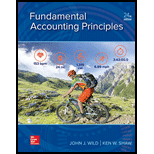
Concept Introduction:
Common Stockholder: Common stockholders are considered as the owner of the company but when it comes to dividend, they come after preference stockholders.
Cumulative
Requirement 1:
If the new business is expected to earn $72,000 of after-tax net income in the first year, what
Answer to Problem 5BTN
Plan B provides higher rate of return.
| Return on beginning equity | Amount | Rate |
| Plan A | $57,600 | 15.36% |
| Plan B | $62,000 | 16.53% |
Explanation of Solution
Plan A: (Issue of 3,750 common stock)
Plan B: (Issue of 1,250 cumulative preferred stock)
Concept Introduction:
Common Stockholder: Common stockholders are considered as the owner of the company but when it comes to dividend, they come after preference stockholders.
Cumulative Preferred Stock: Preference stockholders are preferred first at the time of distribution of dividend. The dividends on cumulative preference stock are fixed and compulsory and if it not paid, it accumulates over the years.
Requirement 2:
Compute the rate of return under each alternative, if the net income after tax is $16,000 and determine which plan results in higher expected return?
Answer to Problem 5BTN
Plan A provides higher rate of return.
| Return on beginning equity | Amount | Rate |
| Plan A | $13,440 | 3.58% |
| Plan B | $6,800 | 1.81% |
Explanation of Solution
Plan A: (Issue of 3,750 common stock)
Plan B: (Issue of 1,250 cumulative preferred stock)
Concept Introduction:
Cumulative preference shares: The preference share on which payment of dividend is compulsory, otherwise accumulates over the year is called cumulative preference shares. The rate of dividend on preference shares are fixed like interest expense on debt funds.
Requirement 3:
Analyze and interpret the difference between the results for parts 1 and 2.
Answer to Problem 5BTN
Considering the results for part 1, the plan B results in higher rate of return but results for part 2 shows a higher rate of return in plan B. Here the amount of net income after tax is a key factor in determining the rate of return on beginning equity if the founder. When it is high, it is favorable for plan A because the preference dividend is easily covered and there is less number of stockholders. But when the net income is low, the preference dividend becomes a burden and there is less amount of income to be distributed among the shareholders.
Explanation of Solution
The 8% dividend on cumulative preferred stock is fixed charge which the company has to pay whether they earn
Want to see more full solutions like this?
Chapter 13 Solutions
FUND.ACCT.PRIN.(LOOSELEAF)-W/ACCESS
- I am looking for help with this general accounting question using proper accounting standards.arrow_forwardI am looking for a step-by-step explanation of this financial accounting problem with correct standards.arrow_forwardCan you solve this general accounting question with accurate accounting calculations?arrow_forward
- Lucas Republic is experiencing a budget deficit of $180 billion. The economy is operating $240 billion below its potential GDP, and the marginal tax rate is 30%. What are the structural deficit and the cyclical deficit?arrow_forwardCan you help me solve this financial accounting question using valid financial accounting techniques?arrow_forwardFinancial Accounting Question please answerarrow_forward
- Please explain the solution to this general accounting problem with accurate explanations.arrow_forwardReef Corporation sells its product for $22 per unit. Next year, fixed expenses are expected to be $385,000 and variable expenses are expected to be $13 per unit. How many units must the company sell to generate a net operating income of $115,000? (Round your answer to nearest unit) Provide answerarrow_forwardCalculate the cost of goods manufacturearrow_forward

 AccountingAccountingISBN:9781337272094Author:WARREN, Carl S., Reeve, James M., Duchac, Jonathan E.Publisher:Cengage Learning,
AccountingAccountingISBN:9781337272094Author:WARREN, Carl S., Reeve, James M., Duchac, Jonathan E.Publisher:Cengage Learning, Accounting Information SystemsAccountingISBN:9781337619202Author:Hall, James A.Publisher:Cengage Learning,
Accounting Information SystemsAccountingISBN:9781337619202Author:Hall, James A.Publisher:Cengage Learning, Horngren's Cost Accounting: A Managerial Emphasis...AccountingISBN:9780134475585Author:Srikant M. Datar, Madhav V. RajanPublisher:PEARSON
Horngren's Cost Accounting: A Managerial Emphasis...AccountingISBN:9780134475585Author:Srikant M. Datar, Madhav V. RajanPublisher:PEARSON Intermediate AccountingAccountingISBN:9781259722660Author:J. David Spiceland, Mark W. Nelson, Wayne M ThomasPublisher:McGraw-Hill Education
Intermediate AccountingAccountingISBN:9781259722660Author:J. David Spiceland, Mark W. Nelson, Wayne M ThomasPublisher:McGraw-Hill Education Financial and Managerial AccountingAccountingISBN:9781259726705Author:John J Wild, Ken W. Shaw, Barbara Chiappetta Fundamental Accounting PrinciplesPublisher:McGraw-Hill Education
Financial and Managerial AccountingAccountingISBN:9781259726705Author:John J Wild, Ken W. Shaw, Barbara Chiappetta Fundamental Accounting PrinciplesPublisher:McGraw-Hill Education





